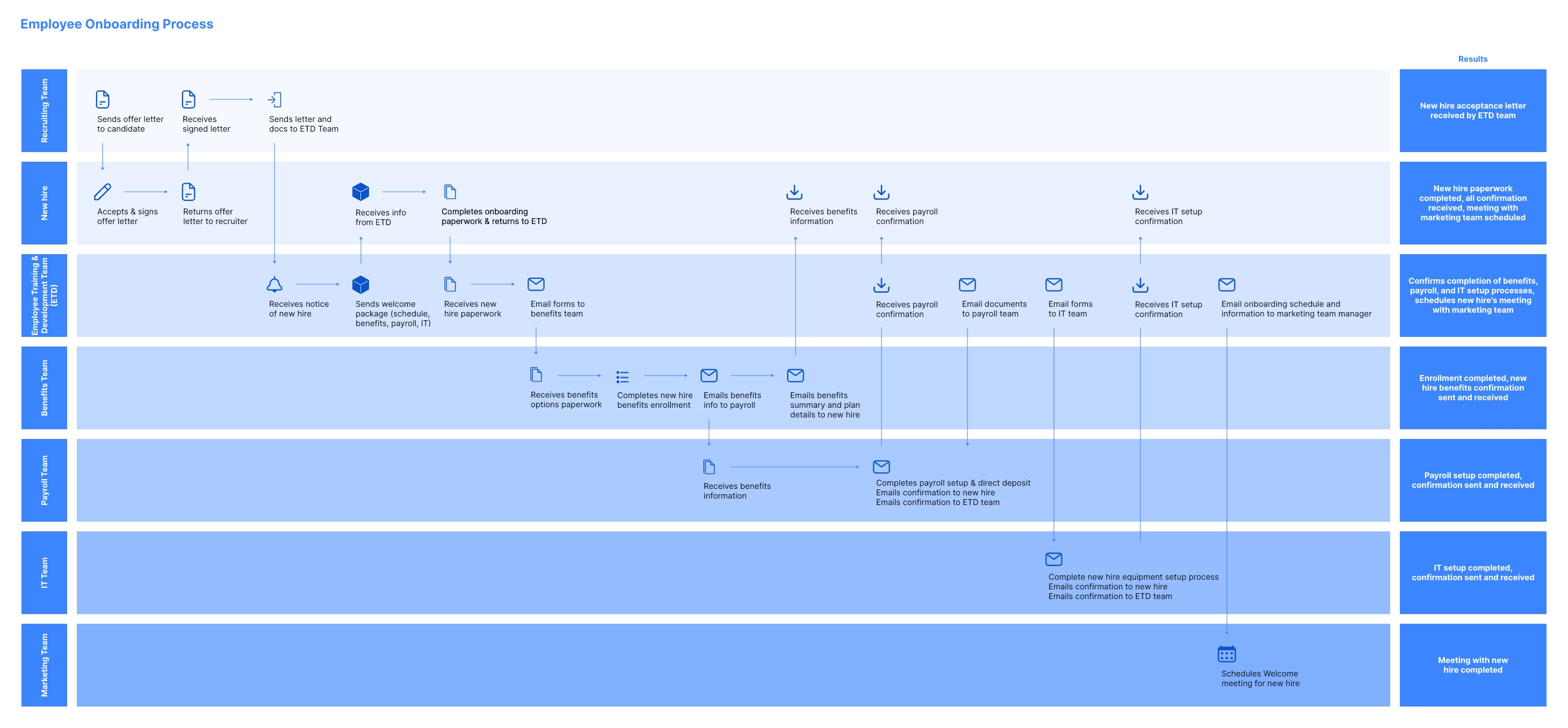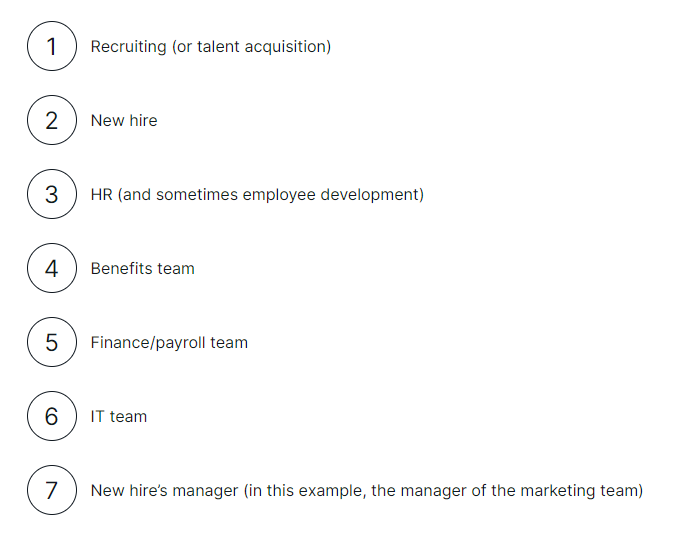Employee onboarding is both a new hire experience and an HR process.
For employees, onboarding is a process that unfolds over several months and sets new hires up for long-term success. For HR teams, it’s also a complex workflow that requires input and action from many departments, especially during the initial stage of onboarding.
In this article, we’ll look at the stages of onboarding as a holistic, long-term strategy for hiring and retaining the best and brightest talent in today’s highly competitive market. We will also look at the initial onboarding workflow(s) and provide a common example of how it’s managed and how it might be improved.
Why is employee onboarding so important?
After a candidate accepts a job offer with a company, the stages of onboarding unfold to help orient and socialize the new hire. Onboarding provides space to set expectations and build relationships that will ideally result in long-term retention of a productive and happy employee.
How well companies manage the employee onboarding process has a direct impact on both the new hire experience and, as a result, overall business performance. Research shows that companies with a structured onboarding process see higher retention and productivity from new hires.

The quality of the onboarding process also affects the turnover rate, which shows up in a company’s bottom line. According to one estimate, it costs a company between $3,000 and $18,000 to replace a new hire.
Other estimates vary depending on the job type and tenure of the position, but the cost to replace a tenured employee can be as high as 30% of their salary, according to one estimate. For an employee with a salary of $60,000, that’s $20,000.

5 stages of employee onboarding
While it’s common to think of onboarding as a process that begins once a candidate accepts an offer, a lot of what happens during the application process actually lays the groundwork for a successful onboarding.
Recruiters and talent acquisition teams gather necessary information from candidates during the application process. Simultaneously, candidates are learning about their role, company culture, and performance expectations.
Stage 1: Pre-onboarding
Once a candidate accepts an offer, the pre-onboarding stage begins. This is the period of time between signing their offer letter and their official first day with the company.
During this phase, documents are signed, onboarding schedules are planned, and relationships begin to form. New hires will likely have many questions and requests as they prepare for their first day with the company. Keep in mind that many employees will be working out their notice with their current employer and possibly even relocating during this phase, so the pre-onboarding process may be even more important in preparing them for their new role.
Stage 2: Initial onboarding (new hire orientation)
Day 1 kicks off the second stage of onboarding. This phase is what many people think of as formal onboarding and can last anywhere from a couple of days to a couple of weeks depending on the role or company.
This stage is structured and aimed at making sure new hires understand company policies and organizational structure.
Several onboarding workflows will take place concurrently during this phase. This includes payroll, benefits enrollment, issuing equipment, and IT setup. Other workflows may also be happening depending on the new hire’s role and company policies. One of the challenges HR teams face during this period is making sure all of these various workflows are unified and that data is shared across several tools and apps without interruption. (More on that below.)
This stage of onboarding typically includes initial training sessions aimed at helping the new employee understand the company as a whole, gaining familiarity with tools and processes, and learning about policies and procedures that are more or less universal for all employees.
Stage 3: Team-focused orientation and training
As the initial onboarding phase begins to conclude, new hires will begin acclimating to their new teams and learning more about the specifics of their role. New hires begin to socialize with their team members and become familiar with the tools they will be using to perform their duties.
New hires will also be introduced to individual and team goals during this stage, and they will begin collaborating with teammates and begin making their first contributions. Perhaps the most critical element of this phase of onboarding is helping the new hire build trust and form relationships within the company. In other words, making the new hire feel at home and at ease. This is especially important if the new hire is working remotely.
To help anchor the new hire in their new role and new team, setting up some initial goals will be crucial during this phase and will give them an opportunity to learn the dynamics of their team.
In most cases, the 30-day milestone will take place during this onboarding stage.
Stage 4: Growth, mentoring, and initial performance
The next phase of employee onboarding is characterized by increasing responsibilities and becoming more familiar with the team and its strategy. Contributions from the new hire will continue to increase during this phase, and initial performance reviews will likely take place.
This onboarding stage typically begins at the 30-day mark and continues for several months, or up until the new employee feels confident and comfortable in their role.
New employees may have a mentor during this phase and will likely have regularly scheduled one-on-one meetings with their manager or a senior team member. The 60-day and 90-day checkpoints usually occur during this phase.
Stage 5: Nurturing and ongoing employee development
After the new employee has passed the 90-day mark, they enter a stage of onboarding that’s all about continuous learning and improvement. By this point, structured onboarding elements will be fewer and further between as team members become more deeply integrated into their work.
Some companies have clearly defined goals for an employee’s continuous learning and improvement; others do not. In either case, the new employee should understand their performance KPIs and the performance review process. They should also continue to participate in regular one-on-one meetings and receive feedback. This will help reassure them when they are on target to meet their goals, and provide constructive criticism when needed.
Example of an HR onboarding workflow
Up to this point we’ve taken a holistic view of onboarding. In this sense, onboarding is a process that plays out over the first days, weeks, and months of a new hire’s employee journey. It orients new hires and helps them acclimate to the company culture so that they become productive members of the team.
While this is vital, It’s also important to think about what onboarding looks like behind the scenes for the team in charge of facilitating it: HR. Onboarding requires collaboration between several departments in order to support new hires and meet internal goals set for the HR team. We can get a sense for just how complex the onboarding process is — and the scope of what HR teams are managing — by zooming in on Stage 2: the initial onboarding.

In this HR onboarding example, it takes input or action from seven different stakeholders to successfully complete the initial onboarding workflow:

This swimlane diagram also illustrates the amount of data that must be collected in order to move the new hire through the onboarding process (a signed offer letter, payroll and benefits enrollment, equipment requests, etc). Since this information may be collected using a range of apps and tools, it’s important to make sure the HR stack is configured to eliminate data silos and avoid repetitive data entry.
Each time information is exchanged between stakeholders, a handoff occurs. These handoffs provide opportunities for bottlenecks or breakdowns in the workflow. (As a general rule, if you are analyzing a workflow for improvement, pay close attention to the handoffs.)
It’s common for workflows to get bogged down simply because items aren’t routed to the correct person, or because someone gets busy and doesn’t realize the item is waiting for their input. It’s also possible for missing or incomplete information to create stalls in the workflow.
All of this amounts to a complex workflow in which a lot of information is exchanged and several dependencies are created. One way HR teams can improve the initial onboarding workflow is through automation.
HR onboarding automation
Automating employee onboarding isn’t about creating a robotic process where new hires have little contact with the HR team. It’s about improving the employee experience by giving HR teams more time to spend with new hires.
Automation handles the repetitive and support tasks that keep items moving through the workflow. This gives HR teams more time to focus on building relationships and helping new hires transition into their roles.
Onboarding automation unifies HR workflows to create a seamless candidate/employee experience. It also makes it easier for team members in other departments to collaborate with HR and get new employees set up quickly. Automation also makes it easier for HR teams to apply their data to overall business strategy by consolidating and centralizing information into customizable dashboards and reports.
Written by Benjamin Babb
